Introduction
Overall Design
{{section_header}}{{section.name}}{{/section_header}}
The {{product.name}} is a relatively good-looking TV, but there's a lot of extra plastic, especially reflective pieces, that don't need to be there. The sides glisten like chrome mirrors. Most of the edges are elegant, but the neck is strangely angular and chunky. Toshiba did a decent job, but they're not playing at the level of Samsung and Sony.
Front
{{section_header}}{{section.name}}{{/section_header}}

Back
{{section_header}}{{section.name}}{{/section_header}}

Sides
{{section_header}}{{section.name}}{{/section_header}}

Stand/Mount
{{section_header}}{{section.name}}{{/section_header}}
Fortunately, the TV panel can swivel on its base, because we found the viewing angle to be terrible.

Controls
{{section_header}}{{section.name}}{{/section_header}}
There are a series of onboard controls that run along the bottom of the bezel. They work, but using them leaves fingerprints.

Remote Control
{{section_header}}{{section.name}}{{/section_header}}
The remote control that ships with the {{product.name}} is simply terrible. There's no other way to describe it. First of all, the backing surface is reflective, creating a glare under lighting that makes it harder to see the buttons. Secondly, the buttons are curved unnecessarily, making them a little less finger-friendly. Third, the d-pad buttons in the center are closely surrounded by a nearly identical set of buttons. A down button located below another down button? A left button next to another left button?? Who's idea was this???
Then there's a whole series of buttons at the bottom that are too small and poorly labeled. They didn't even bother to finish two of the buttons, so there's just two divots.
Overall, it's an ineffective and lazy design.

In the Box
{{section_header}}{{section.name}}{{/section_header}}
The {{product.name}} comes with a series of adapters (2 composite AV adapters and 1 component video adapter). In the box, you'll also get the remote control, batteries, and a lite-version of the instruction manual.
Black Level
{{section_header}}{{section.name}}{{/section_header}}
The {{product.name}} produced a decent black level, but we've seen better from LCD TVs. See the Samsung LN46D550 as a prime example. The Panasonic TC-P42X3, as a plasma TV, was the best of the bunch on this particular test. More on how we test black level.
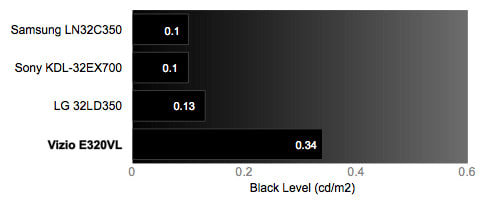
Peak Brightness
{{section_header}}{{section.name}}{{/section_header}}
The {{product.name}} offers a nice, bright white. Anything over 200 cd/m 2 is going to compete adequately with a daylit room. A brightness of 300+ cd/m 2 is even better. More on how we test peak brightness.
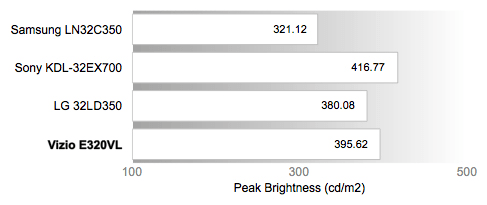
Contrast
{{section_header}}{{section.name}}{{/section_header}}
The contrast ratio simply divides the peak brightness by the black level. Because the {{product.name}} produced a decent black level and good peak brightness, the contrast ratio measured a healthy 3128:1. More on how we test contrast.

Tunnel Contrast
{{section_header}}{{section.name}}{{/section_header}}
The tunnel contrast looks at how well a TV maintains a consistent black level as the amount of black area on the screen varies. As it turns out, the {{product.name}} is pretty stable. Usually LCD TVs do fine on this test, but plasmas have issues. The {{product.name}} is an LCD. More on how we test tunnel contrast.
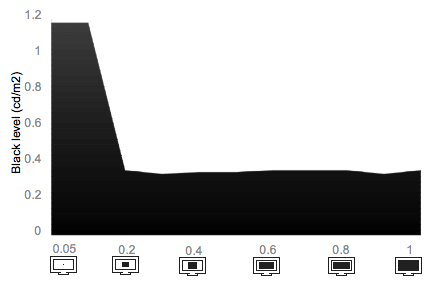
White Falloff
{{section_header}}{{section.name}}{{/section_header}}
The {{product.name}} maintained a perfectly consistent peak brightness. More on how we test white falloff.
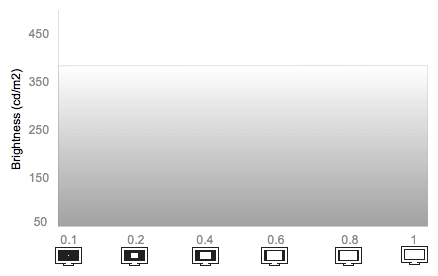
Uniformity
Greyscale Gamma
{{section_header}}{{section.name}}{{/section_header}}
The greyscale gamma test measures how well a TV transitions from black to white. First, we're looking for a smooth line in the chart below. The {{product.name}}'s performance is pretty good. There are only a few little bumps. Each bump indicates an area where you might see banding issues in what should be a smooth gradient. You'll notice a bit of flat area at the upper-right corner of the line, which indicates that the {{product.name}} can't produce any more detail past a certain brightness level. (You'll see a lot more issues like this in the RGB color curve test later in the review).
We're also looking at the slope of the curve. The {{product.name}} has a gamma curve of 2.44. An ideal curve is between 2.1 and 2.2, so the Toshiba's a bit steep. It might miss some of the finer gradations. More on how we test greyscale gamma.
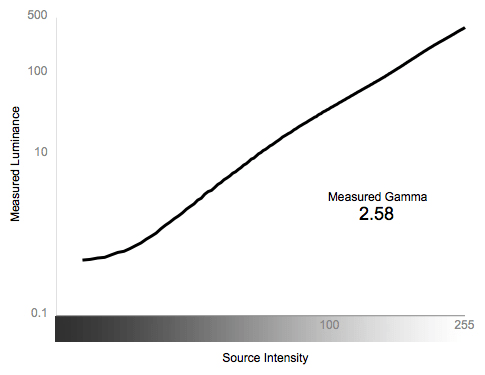
Color Temperature
{{section_header}}{{section.name}}{{/section_header}}
The chart below can be a little misleading, unfortunately. We sample 255 input intensities across the greyscale to measure color temperature, and {{product.name}} managed to land most of those sample points in an "acceptable range." The chart below emphasizes the errors more than you might see them in real life. Hence the high score. More on how we test color temperature.

RGB Curves
{{section_header}}{{section.name}}{{/section_header}}
The {{product.name}} really failed us on the RGB color curve test. As you can see in the chart below, the TV would produce brightness up to a certain level and then just stay there, not displaying any more detail. We played around with the backlight, contrast, brightness, and every other setting, but we couldn't manage to get any more detail. The shadows and mid-tones look great, but the highlights are lost. More on how we test RGB curves.

The strips below are digital recreations of the response curves, compared to three similar TVs as well as ideal response curve.
Motion Performance
{{section_header}}{{section.name}}{{/section_header}}
The {{product.name}}'s motion performance was marred by a fair amount of judder and artifacting. The edges of objects shoos and flickered, losing a lot of detail. High contrast patterns were significantly worse. The {{product.name}} has a motion smoothing feature in the menu, but it didn't seem to have any effect for good or ill. More on how we test motion performance.
3:2 Pulldown & 24fps
{{section_header}}{{section.name}}{{/section_header}}
The {{product.name}} has no problem displaying 24fps video. More on how we test 3:2 pulldown and 24fps.
Resolution Scaling
{{section_header}}{{section.name}}{{/section_header}}
The {{product.name}} is a native 1080p resolution, but most of the video you'll watch is of a lower resolution. It's up to the TV's internal processing to make sense of the video and rescale it to the screen. Overall, it's quite good at this task. More on how we test resolution scaling.
480p
When we looked at 480p content, the {{product.name}} showed absolutely no problems.
720p
The 720p content showed some slight Moire with high contrast, high frequency patterns, but overall it was fine.
Formats
{{section_header}}{{section.name}}{{/section_header}}
The {{product.name}} has a native 1080p (1920 x 1080) resolution, the highest resolution of the HD formats. The TV can handles all standard NTSC formats and rescale them for the screen.
Viewing Angle
{{section_header}}{{section.name}}{{/section_header}}
The {{product.name}}'s viewing angle is shockingly bad. If you move less than 10 degrees from center-of-screen, you lose 50% of the contrast ratio. That's a total viewing angle of only 19 degrees. Even the Samsung LCDs, traditionally very bad, perform better than this.

Reflectance
{{section_header}}{{section.name}}{{/section_header}}
The {{product.name}}'s screen is certainly not the most reflective we've seen, but it's not ideal. When hit with a strong ambient light, there's a diffuse glow on the screen, with four long streaky reflections stretching out in the cardinal directions (presumably this is the result of some sort of light refraction to reduce glare).
Video Processing
{{section_header}}{{section.name}}{{/section_header}}
The {{product.name}} has several video processing features.
Calibration
{{section_header}}{{section.name}}{{/section_header}}
The calibration process for the {{product.name}} was tricky because we just couldn't get the TV to display enough detail in the highlights. We just kept hoping that we'd accidentally left one of the many processing features enabled, or disabled, or set to the wrong level. We also found the menu interface annoying, which slowed down the whole process.

All of our calibration is done in conjunction with the DisplayMate software.
](http://www.displaymate.com/)
Video Modes
{{section_header}}{{section.name}}{{/section_header}}
There are several video modes and each can be customized from its initial settings.
Connectivity
{{section_header}}{{section.name}}{{/section_header}}
The {{product.name}} has a lot of ports for your home theater: four HDMIs, two composite AVs, one component AV, an analog and digital audio out, along with several more, all detailed in the chart below. In addition to the LAN port you see here, there's the unseen but much appreciated WiFi, which is built right into the TV (no additional purchase required).

There are two USB ports near the top that can be used to play back photos and videos from USB mass storage devices.
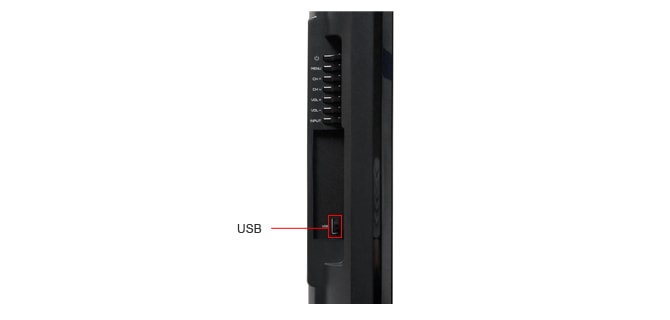
Placement
{{section_header}}{{section.name}}{{/section_header}}
The {{product.name}} ports are all located on the back, arranged in an L-shape. Fortunately, the ports you're more likely to swap out, like AV inputs, are located on the side. Those less likely to be changed often, like LAN or digital audio out, are located along the bottom and harder to access. The labeling is not particularly clear in some parts, but you'll piece it together.
Audio Quality
{{section_header}}{{section.name}}{{/section_header}}
The {{product.name}}'s audio performance is terrible, not dissimilar to two tin cans tied together with string. There is absolutely no bass response. If you need to hear characters talking, you'll be fine. If you want it to sound "good," you'll want to plug this into a standalone audio system or get a better TV.
Menu Interface
{{section_header}}{{section.name}}{{/section_header}}
At first look, the {{product.name}}'s menu is cool. Second time, a little less cool. Third time and onward, annoying. The interface, as you can see in the first photo below, is built on a series of pop-up, nested, scrolling sub-menus. The problem is that it's very difficult to determine what these sub-menus contain. Just to calibrate the picture settings, we had to use three separate sub-menus.

Once you open any of the sub-menus, you're presented with a more traditional list of items. If they'd just stuck with this for the whole interface, it would have been effective than the cutesy pop-up business.

Instruction Manual
{{section_header}}{{section.name}}{{/section_header}}
The instruction manual that ships with the {{product.name}} is merely an at-a-glance guide for setting up the TV. To get your questions answered, you'll need to download a digital version here . This version is great, with easy navigation and solid descriptions of all the features.

A manual for so many TV models, they have to be further categorized by type.
Internet Features
{{section_header}}{{section.name}}{{/section_header}}
We had a bit of an issue with testing the {{product.name}}'s internet features, as it never worked. We tried activating the Net TV features, then Netflix, then the Yahoo features. No luck. Then we ran a software update and tried again. Nope. Restart the TV, and again, and again. Nothing doing. That little bar in the bottom never got past the "Searching for available updates" stage. We're not sure if this is a result of faulty software, firmware, or hardware. Regardless, we're scoring on what we expect a working model would get.
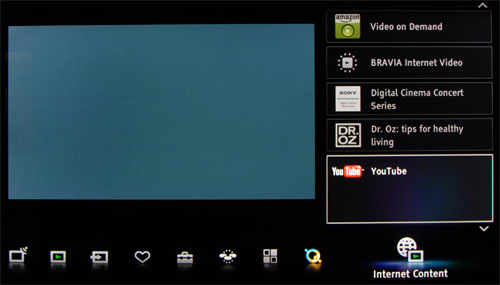
That said, we can make some assumptions about the internet features, were they to work. Like many TV manufacturers, Toshiba has made a meal of partnering with Netflix by putting a branded button right on the remote control. There's a matching one for Yahoo. Toshiba continues to use Yahoo's plug-and-play content platform, an interface we've found to be painfully sluggish and awkwardly designed in every other iteration. It's probably no different here. But you can't argue with the video and music services themselves: Netflix, Blockbuster, Vudu, YouTube, Cinema Now, and Yahoo, plus whatever Yahoo adds to the ever-expanding line-up.
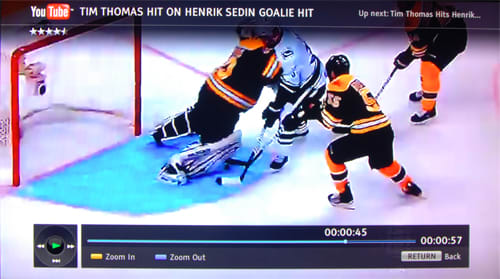
The YouTube playback is a wonderful thing.
Connecting to networks in no problem, as the {{product.name}} features both ethernet and built-in WiFi. The TV is also DLNA certified, so you can connect to a home entertainment network.
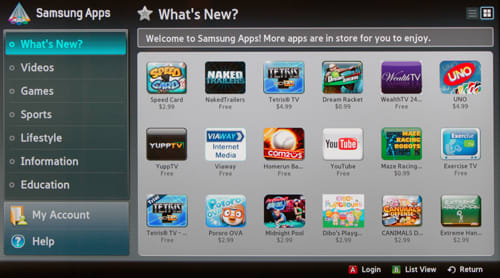
There are also plenty of games to download, free and paid, new and classic
Local Media Playback
{{section_header}}{{section.name}}{{/section_header}}
The {{product.name}} has two USB ports that can play photos, video clips, and music files from USB mass storage devices. The interface is straightforward and there are several options for creating custom playlists and slideshows.

Power Consumption
{{section_header}}{{section.name}}{{/section_header}}
The {{product.name}} arrives with an Energy Star sticker right on the front and it certainly deserves it. At the minimum recommended backlight setting it would cost only $12.69, approximately. Even at maximum backlight it's only $17.28 per year.
That compares very favorably to last year's Toshiba 46XV648U and the Samsung LN46D550, both LCDs like the {{product.name}}. The Panasonic TC-P42X3 is a plasma, which typically require more power, though the X3 was particularly power efficient.
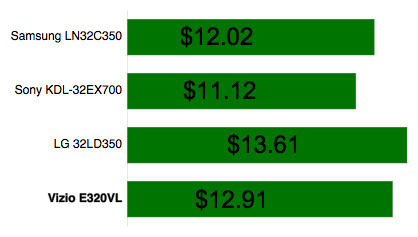
Value Comparison
{{section_header}}{{section.name}}{{/section_header}}
The Panasonic TC-P42X3 retails for less than the {{product.name}} (MSRPs of $599 versus $1099), but the Panasonic has some pleasant surprises and the {{product.brand.name}} has some real shortcomings. Granted, the Panasonic is mired in a 720p resolution, but the color and motion performances are a little better. Neither are perfect TVs, but read the descriptions below and be the judge.
Blacks & Whites
{{section_header}}{{section.name}}{{/section_header}}
The {{product.name}} could not match the black level of a plasma TV like the Panasonic TC-P42X3. However, plasmas rarely get as bright as LCD TVs. All in all, the {{product.name}} had a wider contrast ratio than the Panasonic.

Color Accuracy
{{section_header}}{{section.name}}{{/section_header}}
The {{product.name}} had a harder time maintaining a consistent color temperature, but it averaged out to about even with the Panasonic. Neither TV did well in the RGB Curves test. The {{product.name}} peaked way too early, and the Panasonic TC-P42X3 suddenly dipped at the brightest values (due to poorly programmed auto screen dimming).
Motion
{{section_header}}{{section.name}}{{/section_header}}
The {{product.name}} was no winner in our motion tests. There was a lot of judder and artifacting. The Panasonic TC-P42X3 was not an exemplar of motion performance but fared a little better.
Viewing Effects
{{section_header}}{{section.name}}{{/section_header}}
The Panasonic TC-P42X3, as a plasma, has a far wider viewing angle than the {{product.name}}.
Connectivity
{{section_header}}{{section.name}}{{/section_header}}
The {{product.name}} offers far more connectivity options, including two more HDMIs and built-in WiFi.
Value Comparison
{{section_header}}{{section.name}}{{/section_header}}
The Samsung LN46D550 ($899 MSRP) is a cheaper than the {{product.name}} ($1099 MSRP), but offers some compelling performance. It uses the older CCLF backlighting, but we don't see a huge advantage in the Toshiba's LED backlighting. The Samsung also lacks the internet connectivity and streaming media options. If you can live with that, you'll save yourself some dough.
Blacks & Whites
{{section_header}}{{section.name}}{{/section_header}}
The Samsung LN46D550 managed deeper black levels than the {{product.name}}, as well as brighter whites. That's pretty much the definition of a wider contrast ratio. However, the Toshiba was a little better at producing detail in the shadows.

Color Accuracy
{{section_header}}{{section.name}}{{/section_header}}
Unfortunately, the chart below can be a little misleading. The {{product.name}} offers a less consistent color temperature, but it actually had more sample points in the accepted zone. The Samsung LN46D550 looks more consistent, but in the raw data, you can see that it was more frequently amiss. They're both pretty good, though.
Motion
{{section_header}}{{section.name}}{{/section_header}}
Neither the {{product.name}} nor the Samsung LN46D550 were champions when it came to motion performance. Both showed some noticeable artifacting.
Viewing Effects
{{section_header}}{{section.name}}{{/section_header}}
The {{product.name}} has a terrible viewing angle, even worse than the Samsung LN46D550, which was pretty bad itself.
Connectivity
{{section_header}}{{section.name}}{{/section_header}}
The Samsung LN46D550 has offers more AV inputs, but lacks the built-in WiFi of the {{product.name}}.
Value Comparison
{{section_header}}{{section.name}}{{/section_header}}
The Toshiba 46XV648U is an older model from 2010, and though it originally retailed for nearly $700 more than the {{product.name}}, but because of its age you'll probably be able to pick it up at a discount. The performance is better in most regards, but it lacks the internet connectivity.
Blacks & Whites
{{section_header}}{{section.name}}{{/section_header}}
The {{product.name}} produced deeper blacks than the Toshiba 46XV648U, which gave it a slightly wider contrast ratio.

Color Accuracy
{{section_header}}{{section.name}}{{/section_header}}
The {{product.name}} showed a lot of problems with the RGB curves test, in which all the color channels were peaking too early. The Toshiba 46XV648U was much better in this regard. The color temperature test results were nearly identical.
Motion
{{section_header}}{{section.name}}{{/section_header}}
The Toshiba 46XV648U was significantly better at producing smooth, artifact-free motion performance.
Viewing Effects
{{section_header}}{{section.name}}{{/section_header}}
The Toshiba 46XV648U also had a much wider viewing angle.
Connectivity
{{section_header}}{{section.name}}{{/section_header}}
The Toshiba 46XV648U lacks one of the HDMI inputs, but has one additional component AV input. The biggest difference is that the 46XV648U lacks the internet connectivity of the {{product.name}}.
Conclusion
The {{product.name}} does not live up to its $1099 MSRP. While the black levels and contrast ratio are decent, the TV choked in our color performance tests. A viewing angle of 19 degrees is unacceptable in a time when engineers are finding news ways to expand the viewing angle of LCD panels. A software malfunction (presumably) prevented the internet features from ever loading. We're not sure if this is network wide or just our unit. The built-in speakers sound like a tin cans. The remote control is ugly and we hate it.
There are great Toshiba TVs out there. We've seen them. The {{product.model}} does not number among them.
Model Series Comparison
{{section_header}}{{section.name}}{{/section_header}}
There are three sizes in the xxSL417U series. All share the same strengths and weaknesses. All include built-in WiFi, DLNA support, and connection to the same streaming content options.
Photo Gallery
{{photo_gallery "Front Tour Image", "Back Tour Image", "Sides Tour Image", "Stand Photo", "Controls Photo", "Remote Control Photo", "Connectivity Tour Image 1", "Connectivity Tour Image 2", "Connectivity Extra Photo", "Menu Main Photo", "Menu 2 Photo", "Internet Features 1 Photo", "Internet Features 2 Photo", "Internet Features 3 Photo", "Local Media Playback 1 Photo", "Local Media Playback 2 Photo"}}
Ratings & Specs
{{manufacturer_specs_table}}
Meet the tester
David Kender oversees content at Reviewed as the Editor in Chief. He served as managing editor and editor in chief of Reviewed's ancestor, CamcorderInfo.com, helping to grow the company from a tiny staff to one of the most influential online review resources. In his time at Reviewed, David has helped to launch over 100 product categories and written too many articles to count.
Checking our work.
Our team is here for one purpose: to help you buy the best stuff and love what you own. Our writers, editors, and lab technicians obsess over the products we cover to make sure you're confident and satisfied. Have a different opinion about something we recommend? Email us and we'll compare notes.
Shoot us an email
